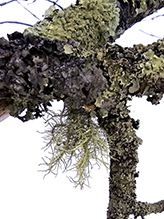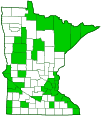Powder-tipped Shadow Lichen
(Phaeophyscia adiastola)
Conservation • Description • Ecology • Distribution • Taxonomy
|
|
||||||||||||||
Description |
Powder-tipped Shadow Lichen is a common wreath lichen. It occurs in the United States and southern Canada east of the Great Plains, and there are just a handful of records in the west. It is not uncommon in Minnesota. Powder-tipped Shadow Lichen is most common on moss-covered, coarse-grained, crystalline (granitic) rock and on the bark of deciduous trees, but it also grows on bare rock and bark of coniferous trees. The vegetative body (thallus) is leaf-like (foliose). It is divided into radiating lobes forming a circular or irregular rosette. The rosette can be up to 4″ (10 cm) in diameter, but it is usually no more than 2⅜″ (6 cm) in diameter. It is held to the substrate (bark) by black, unbranched, root-like structures (rhizines). The rhizines do not extend beyond the margins of the thalli. The primary lobes are 1 ⁄64″ to 1⁄16″ (0.5 to 1.5 mm) wide. They are usually convex, sometimes flat, and they are usually long and narrow. The sides are straight. The tips may be rounded or straight across (truncate). The lobes may overlap or be non-overlapping (discrete). The upper side is hairless and greenish gray to dark gray or pale brown. The underside is black, sometimes paler at the lobe ends. The upper and lower surfaces of the lichen are formed of tightly packed, interwoven, fungal threads (hyphae) going in all directions (paraplectenchymatous). The paraplectenchymatous lower surface is one of the features that distinguish the genus Phaeophyscia from the genus Physcia. Cortex-free areas of the thallus (soralia), mostly at the ends of the lobes and on the margins, produce reproductive growths (soredia). The soredia may be finely granular, or they may be in clusters with an outer protective layer. They are often in piles, but the soralia are not strongly cap-like. Disk-like, spore-producing structures (apothecia) are infrequent to rare. When present, they are stalkless, are up to ⅛″ (3 mm) in diameter, and have a thick margin. |
Similar Species |
Ecology |
Substrate |
Moss-covered rock and bark |
Growth Form |
Foliose |
Habitat |
|
Hosts |
|
Distribution |
||
|
Sources |
|
| 1/21/2025 | ||
Occurrence |
||
Common |
||
Taxonomy |
|
Kingdom |
Fungi (Fungi) |
Subkingdom |
Dikarya |
Phylum |
Ascomycota (Sac Fungi) |
Subphylum |
Pezizomycotina (Sac Fungi and Lichens) |
Class |
Lecanoromycetes (Common Lichens) |
Subclass |
Lecanoromycetidae (Shield Lichens, Sunburst Lichens, Rosette Lichens, and Allies) |
Order |
Caliciales (button lichens, rosette lichens, and allies) |
Family |
Physciaceae (rosette lichens, frost lichens, and allies) |
Genus |
Phaeophyscia (wreath lichens) |
Mycobiont |
Phaeophyscia adiastola |
Photobiont |
|
This species was originally described as Physcia adiastola in 1977. Prior to that time, it was confused with Phiscia orbicularis. In a review of the lichen genus Physcia (Moberg, 1977) the author erected the new genus Phaeophyscia for the 8 Finnish species that were formerly in the Physcia orbicularis group. Species in this group lack atranorin, often have a brownish coloration, and possess ellipsoid conidia less than 4 µm in length. In 1978 Physcia adiastola was moved to the genus Phaeophyscia. |
|
Subordinate Taxa |
|
|
|
Synonyms |
|
Physcia adiastola |
|
Common Names |
|
Powder-tipped Shadow Lichen |
|
Glossary
Apothecium
An open, disk-shaped or cup-shaped, reproductive structure, with spore sacs on the upper surface, that produces spores for the fungal partner of a lichen. Plural: apothecia.
Foliose
Leaf-like; referring to lichens with thin, flat, leaf-like growths divided into lobes which are free from the substrate.
Hypha
A thread-like cell of a fungus that is the main mode of vegetative growth: the basic structural unit of a multicellular fungus. Plural: hyphae. Collectively, the hyphae of a fungus is the mycelium.
Isidium
An asexual reproductive structure of a lichen in the form of a tiny outgrowth of the upper cortex. It consists of a cluster of algal cells (the photobiont) wrapped in fungal filaments (the mycobiont), and a shiny outer layer of protective tissue (cortex). Plural: isidia.
Rhizine
A root-like structure of a lichen that attaches the lower layer to the substrate.
Rosette
A radiating group or cluster of leaves usually on or close to the ground.
Soralium
On lichens, an area on the thallus with no cortex, usually on or near the margin or the tip of a lobe, on which soredia are produced. Plural: soralia.
Soredium
An asexual reproductive structure of a lichen in the form of a tiny dull granule on the thallus surface that can be easily brushed off. It consists of a cluster of algal cells (the photobiont) wrapped in fungal filaments (the mycobiont), but without an outer layer of protective tissue (cortex). Plural: soredia.
Thallus
In lichens: The vegetative body of a lichen composed of both the alga and the fungus. In liverworts: a flat, relatively undifferentiated plant body. Plural: thalli.
Visitor Photos |
||
Share your photo of this lichen. |
||
This button not working for you? |
||
Luciearl |
 |
Bristle beard lichen(hanging), also pom pom shadow lichen, powder tipped-shadow lichen? |
MinnesotaSeasons.com Photos |
||
|
|
|
|
|
|

Slideshows |
|

Visitor Videos |
||
Share your video of this lichen. |
||
This button not working for you? |
||
|
Other Videos |
||
|

Visitor Sightings |
||
Report a sighting of this lichen. |
||
This button not working for you? |
||
| Luciearl March 2023 |
Location: Lake Shore, MN Bristle beard lichen (hanging), also pom pom shadow lichen, powder tipped-shadow lichen? |
 |
MinnesotaSeasons.com Sightings |
||
|

Created: 1/21/2025 Last Updated: © MinnesotaSeasons.com. All rights reserved. |
